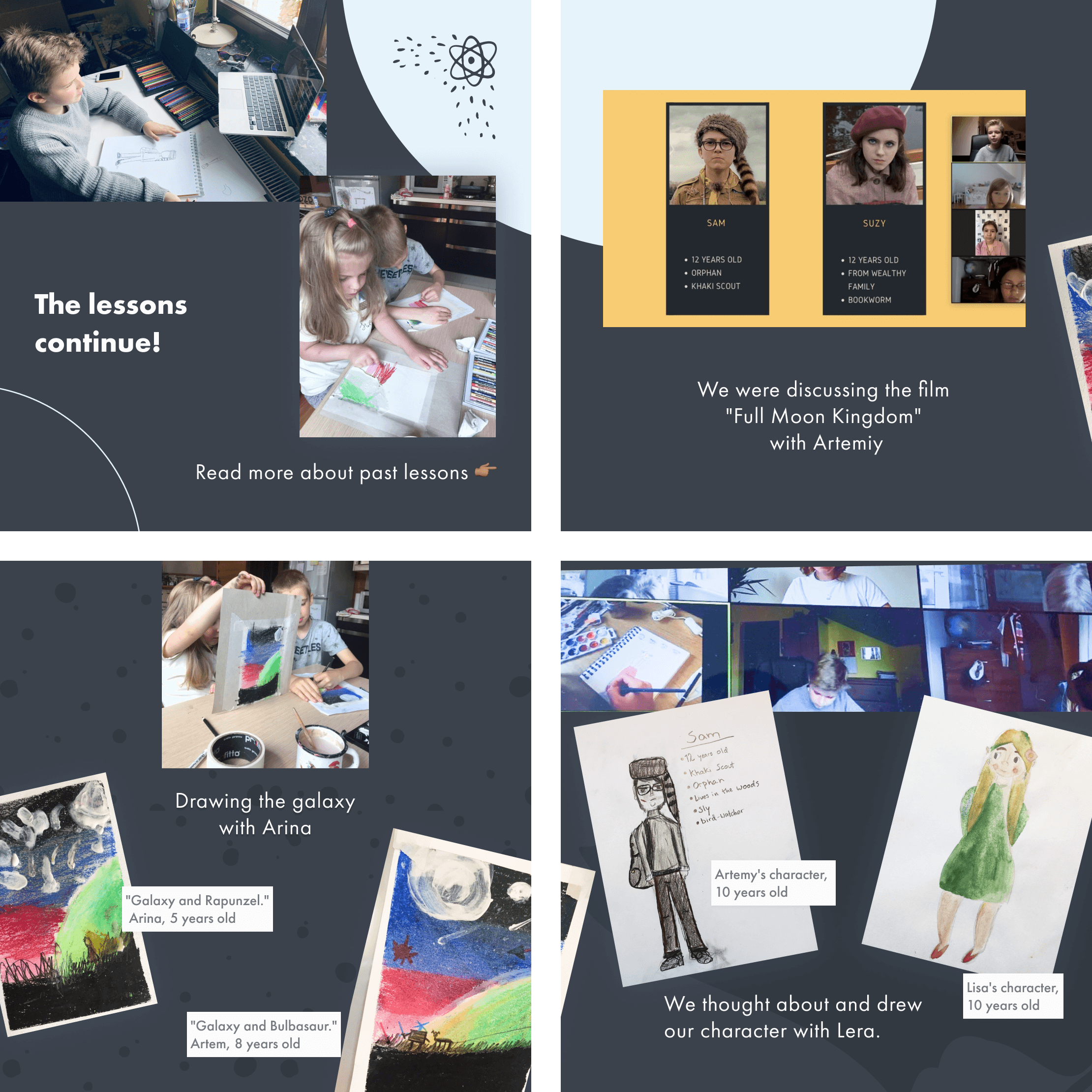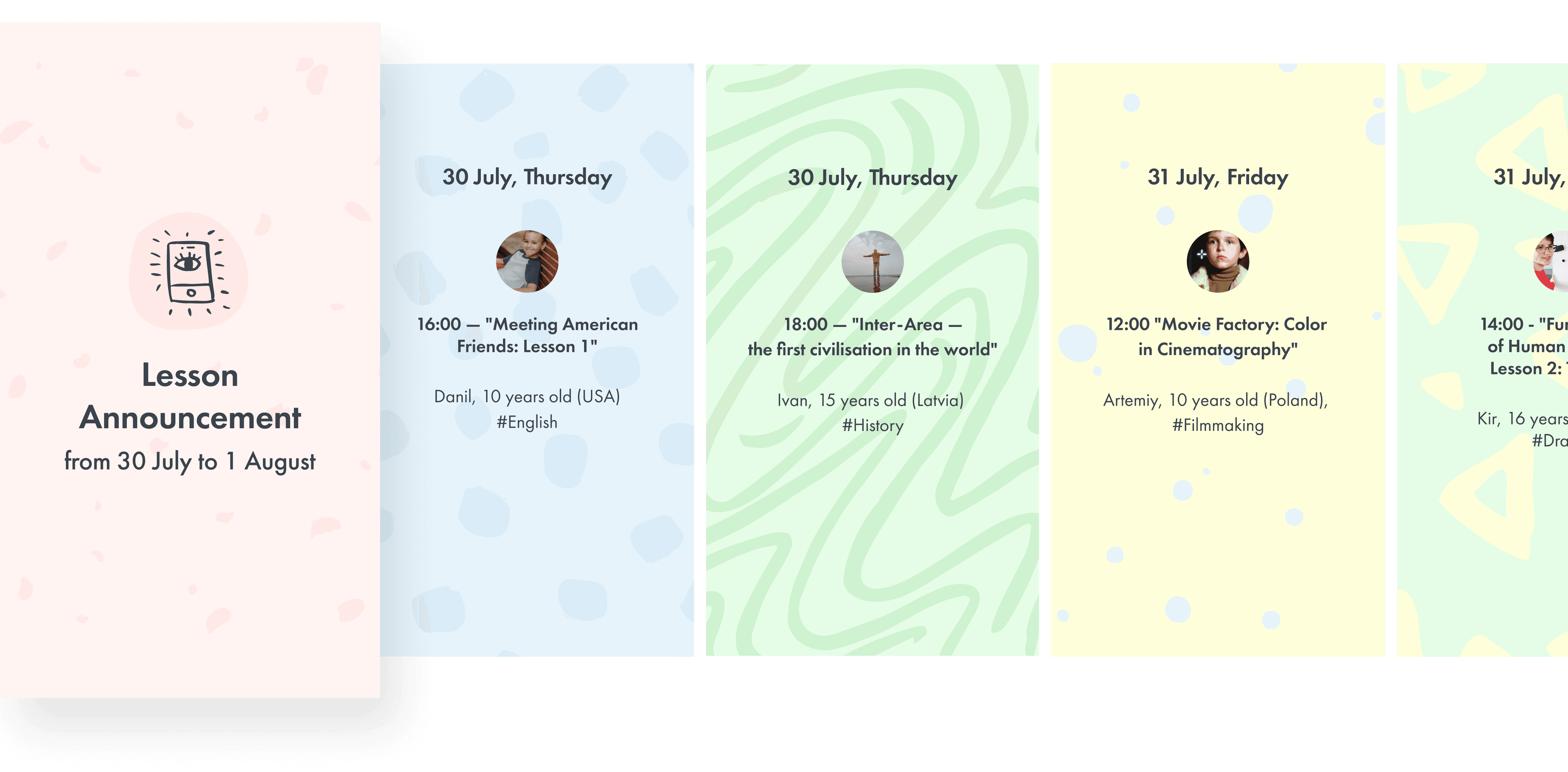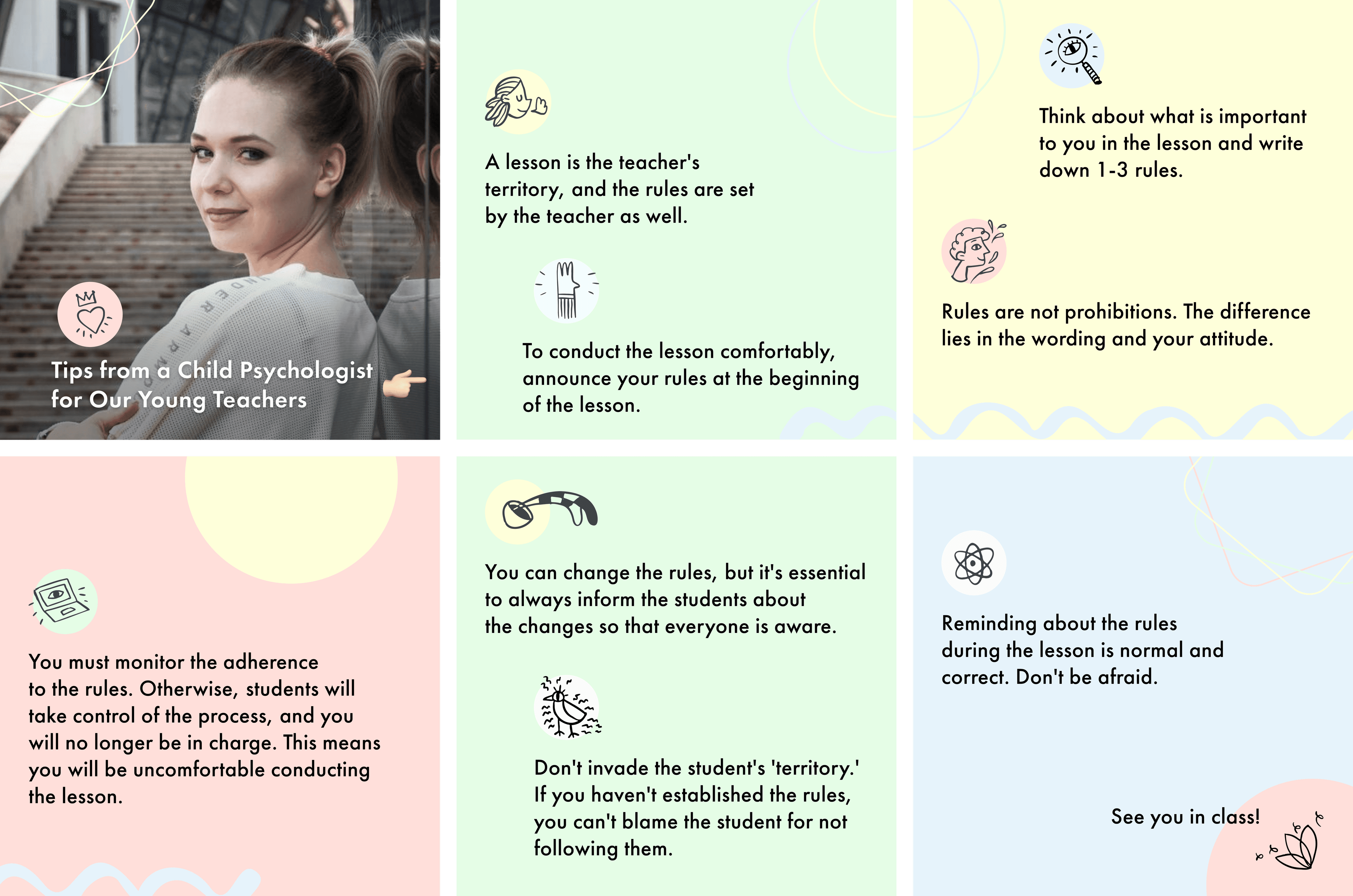My journey as an educational start-up founder
My journey as an educational start-up founder
My journey as an educational start-up founder
Transforming online education with the power and challenges of youth-driven lessons.
Transforming online education with the power and challenges of youth-driven lessons.
Transforming online education with the power and challenges of youth-driven lessons.



Inception of ideas
We initiated this project with two primary hypotheses: first, that children can effectively teach one another, and second, that they are motivated to earn by sharing their knowledge and skills.
The idea was sparked when my eldest son became engrossed in an online history lesson taught by a 14-year-old. Witnessing his potential ignited our belief in this concept.

Team formation
My co-founder, Kate Bovkunova, and I began by assembling our first group of volunteers, consisting of both teachers and students. Surprisingly, recruiting teachers was easier, and their willingness to also take on the role of students was beneficial for practice. In the end, we gathered 20 children from around the world through social media.

Instagram post-report on conducted lessons
Educational materials and platform
To ensure proper quality, we engaged a presentation specialist who taught the children how to organise presentations in a way that would make them interesting.
In the future, this series of lectures was used as mandatory study material for all newly arrived young teachers.
Successful launch
The pilot launch exceeded our expectations, relying heavily on word-of-mouth. We didn't spend a dime on advertising, yet children and teachers alike kept coming.

Zoom lesson title slide
Lesson announcements
For the child, it was essential that each of their lessons was promoted on our social media. The design of the announcements conveyed the unique personality of each teacher and their subject, which enhanced the teacher's confidence in themselves and their talent.

Examples of Instagram Stories Announcements
Technological stack
To execute this project, we assembled a no-code platform, combining:
Tilda
Zapier
Zoom
Google Sheets
PayPal
Support and inspiration
Along the way, we managed to attract many informational sponsors, both companies and influencers, who freely shared information about our project on their social media. Their support was truly inspiring.
We also brought in a psychologist who conducted lectures on maintaining audience engagement and managing stage fright.

A multi-page post with key takeaways after the psychologist's lecture.
Feedback from one of the student's fathers

Ivan Koshurin: "Children are not afraid to learn and make mistakes if they see that another child is teaching them. Yes, it's not a school program and not a methodology repeated for the tenth year in a row. It's live communication, sharing life experiences, and just an hour of time spent with friends."
Rapid growth and initial challenges
Throughout the entire project, the audience growth was primarily organic, without the use of paid promotions. We invested significant resources in the development of social media, from where we also acquired paying customers.
The project grew rapidly; yesterday's novice teachers were already training newcomers and even acted as tutors in online lessons.
Our landing page underwent dozens of changes. One of the main metrics we focused on was the number of requests for paid lessons.
Two months after the project's launch, we were able to secure our first paying customers.
The project grew faster than our resources. Despite the fact that some teenage teachers helped us with operational tasks on a voluntary basis.
As the project grew, serious obstacles began to emerge.
Overcoming challenges
As the project progressed, we discovered issues that posed serious barriers to scaling the business.
Managing remote stress: One of the most challenging and sensitive issues was supporting young teachers managing stress remotely. Minor technical glitches, such as Zoom errors or malfunctioning microphones, led children to become extremely anxious and sometimes cry. This necessitated the presence of an adult and experienced tutor during each lesson to offer moral and technical support.
Lesson safety: To ensure the safety of the online lessons and prevent unauthorized access, a dedicated curator was essential.
Scheduling conflicts: With the onset of the academic year, scheduling became problematic. Young teachers, balancing their own studies, often had to decline teaching sessions to focus on their homework. This led us to introduce a substitute system. However, this system had its own set of challenges.
Contractual limitations: In most jurisdictions, minors can't enter into legally binding contracts. This prevented us from ensuring that the children maintained schedules, punctuality, and other commitments.
Competition with traditional learning: Our model faced tough competition from traditional tutoring methods, which generally maintained a higher standard of discipline and education.
Parental influence: There were concerns regarding the undue influence of some parents on their children. It became challenging to discern between a child's genuine interest in teaching and the potential ulterior motives of the parents.
Project conclusion
Ultimately, we realised that turning this project into a viable business model was not possible due to legal and, most importantly, ethical barriers.
Support and commitment to children
However, we are proud that we were able to provide children with an opportunity to showcase their talents and believe in themselves. Even after the project's closure, the children continued to stay connected and organize sessions on a self-organized basis.
Co-founder's feedback

"Masha pushes our team forward. She doesn't just talk; her creative energy shows in her work. People notice her designs because they look great, which brings in new clients and partnerships".
Kate Bovkunova, co-founder @PeerToPeer
Inception of ideas
We initiated this project with two primary hypotheses: first, that children can effectively teach one another, and second, that they are motivated to earn by sharing their knowledge and skills.
The idea was sparked when my eldest son became engrossed in an online history lesson taught by a 14-year-old. Witnessing his potential ignited our belief in this concept.

Team formation
My co-founder, Kate Bovkunova, and I began by assembling our first group of volunteers, consisting of both teachers and students. Surprisingly, recruiting teachers was easier, and their willingness to also take on the role of students was beneficial for practice. In the end, we gathered 20 children from around the world through social media.

Instagram post-report on conducted lessons
Educational materials and platform
To ensure proper quality, we engaged a presentation specialist who taught the children how to organise presentations in a way that would make them interesting.
In the future, this series of lectures was used as mandatory study material for all newly arrived young teachers.
Successful launch
The pilot launch exceeded our expectations, relying heavily on word-of-mouth. We didn't spend a dime on advertising, yet children and teachers alike kept coming.

Zoom lesson title slide
Lesson announcements
For the child, it was essential that each of their lessons was promoted on our social media. The design of the announcements conveyed the unique personality of each teacher and their subject, which enhanced the teacher's confidence in themselves and their talent.

Examples of Instagram Stories Announcements
Technological stack
To execute this project, we assembled a no-code platform, combining:
Tilda
Zapier
Zoom
Google Sheets
PayPal
Support and inspiration
Along the way, we managed to attract many informational sponsors, both companies and influencers, who freely shared information about our project on their social media. Their support was truly inspiring.
We also brought in a psychologist who conducted lectures on maintaining audience engagement and managing stage fright.

A multi-page post with key takeaways after the psychologist's lecture.
Feedback from one of the student's fathers

Ivan Koshurin: "Children are not afraid to learn and make mistakes if they see that another child is teaching them. Yes, it's not a school program and not a methodology repeated for the tenth year in a row. It's live communication, sharing life experiences, and just an hour of time spent with friends."
Rapid growth and initial challenges
Throughout the entire project, the audience growth was primarily organic, without the use of paid promotions. We invested significant resources in the development of social media, from where we also acquired paying customers.
The project grew rapidly; yesterday's novice teachers were already training newcomers and even acted as tutors in online lessons.
Our landing page underwent dozens of changes. One of the main metrics we focused on was the number of requests for paid lessons.
Two months after the project's launch, we were able to secure our first paying customers.
The project grew faster than our resources. Despite the fact that some teenage teachers helped us with operational tasks on a voluntary basis.
As the project grew, serious obstacles began to emerge.
Overcoming challenges
As the project progressed, we discovered issues that posed serious barriers to scaling the business.
Managing remote stress: One of the most challenging and sensitive issues was supporting young teachers managing stress remotely. Minor technical glitches, such as Zoom errors or malfunctioning microphones, led children to become extremely anxious and sometimes cry. This necessitated the presence of an adult and experienced tutor during each lesson to offer moral and technical support.
Lesson safety: To ensure the safety of the online lessons and prevent unauthorized access, a dedicated curator was essential.
Scheduling conflicts: With the onset of the academic year, scheduling became problematic. Young teachers, balancing their own studies, often had to decline teaching sessions to focus on their homework. This led us to introduce a substitute system. However, this system had its own set of challenges.
Contractual limitations: In most jurisdictions, minors can't enter into legally binding contracts. This prevented us from ensuring that the children maintained schedules, punctuality, and other commitments.
Competition with traditional learning: Our model faced tough competition from traditional tutoring methods, which generally maintained a higher standard of discipline and education.
Parental influence: There were concerns regarding the undue influence of some parents on their children. It became challenging to discern between a child's genuine interest in teaching and the potential ulterior motives of the parents.
Project conclusion
Ultimately, we realised that turning this project into a viable business model was not possible due to legal and, most importantly, ethical barriers.
Support and commitment to children
However, we are proud that we were able to provide children with an opportunity to showcase their talents and believe in themselves. Even after the project's closure, the children continued to stay connected and organize sessions on a self-organized basis.
Co-founder's feedback

"Masha pushes our team forward. She doesn't just talk; her creative energy shows in her work. People notice her designs because they look great, which brings in new clients and partnerships".
Kate Bovkunova, co-founder @PeerToPeer
Inception of ideas
We initiated this project with two primary hypotheses: first, that children can effectively teach one another, and second, that they are motivated to earn by sharing their knowledge and skills.
The idea was sparked when my eldest son became engrossed in an online history lesson taught by a 14-year-old. Witnessing his potential ignited our belief in this concept.

Team formation
My co-founder, Kate Bovkunova, and I began by assembling our first group of volunteers, consisting of both teachers and students. Surprisingly, recruiting teachers was easier, and their willingness to also take on the role of students was beneficial for practice. In the end, we gathered 20 children from around the world through social media.

Instagram post-report on conducted lessons
Educational materials and platform
To ensure proper quality, we engaged a presentation specialist who taught the children how to organise presentations in a way that would make them interesting.
In the future, this series of lectures was used as mandatory study material for all newly arrived young teachers.
Successful launch
The pilot launch exceeded our expectations, relying heavily on word-of-mouth. We didn't spend a dime on advertising, yet children and teachers alike kept coming.

Zoom lesson title slide
Lesson announcements
For the child, it was essential that each of their lessons was promoted on our social media. The design of the announcements conveyed the unique personality of each teacher and their subject, which enhanced the teacher's confidence in themselves and their talent.

Examples of Instagram Stories Announcements
Technological stack
To execute this project, we assembled a no-code platform, combining:
Tilda
Zapier
Zoom
Google Sheets
PayPal
Support and inspiration
Along the way, we managed to attract many informational sponsors, both companies and influencers, who freely shared information about our project on their social media. Their support was truly inspiring.
We also brought in a psychologist who conducted lectures on maintaining audience engagement and managing stage fright.

A multi-page post with key takeaways after the psychologist's lecture.
Feedback from one of the student's fathers

Ivan Koshurin: "Children are not afraid to learn and make mistakes if they see that another child is teaching them. Yes, it's not a school program and not a methodology repeated for the tenth year in a row. It's live communication, sharing life experiences, and just an hour of time spent with friends."
Rapid growth and initial challenges
Throughout the entire project, the audience growth was primarily organic, without the use of paid promotions. We invested significant resources in the development of social media, from where we also acquired paying customers.
The project grew rapidly; yesterday's novice teachers were already training newcomers and even acted as tutors in online lessons.
Our landing page underwent dozens of changes. One of the main metrics we focused on was the number of requests for paid lessons.
Two months after the project's launch, we were able to secure our first paying customers.
The project grew faster than our resources. Despite the fact that some teenage teachers helped us with operational tasks on a voluntary basis.
As the project grew, serious obstacles began to emerge.
Overcoming challenges
As the project progressed, we discovered issues that posed serious barriers to scaling the business.
Managing remote stress: One of the most challenging and sensitive issues was supporting young teachers managing stress remotely. Minor technical glitches, such as Zoom errors or malfunctioning microphones, led children to become extremely anxious and sometimes cry. This necessitated the presence of an adult and experienced tutor during each lesson to offer moral and technical support.
Lesson safety: To ensure the safety of the online lessons and prevent unauthorized access, a dedicated curator was essential.
Scheduling conflicts: With the onset of the academic year, scheduling became problematic. Young teachers, balancing their own studies, often had to decline teaching sessions to focus on their homework. This led us to introduce a substitute system. However, this system had its own set of challenges.
Contractual limitations: In most jurisdictions, minors can't enter into legally binding contracts. This prevented us from ensuring that the children maintained schedules, punctuality, and other commitments.
Competition with traditional learning: Our model faced tough competition from traditional tutoring methods, which generally maintained a higher standard of discipline and education.
Parental influence: There were concerns regarding the undue influence of some parents on their children. It became challenging to discern between a child's genuine interest in teaching and the potential ulterior motives of the parents.
Project conclusion
Ultimately, we realised that turning this project into a viable business model was not possible due to legal and, most importantly, ethical barriers.
Support and commitment to children
However, we are proud that we were able to provide children with an opportunity to showcase their talents and believe in themselves. Even after the project's closure, the children continued to stay connected and organize sessions on a self-organized basis.
Co-founder's feedback

"Masha pushes our team forward. She doesn't just talk; her creative energy shows in her work. People notice her designs because they look great, which brings in new clients and partnerships".
Kate Bovkunova, co-founder @PeerToPeer